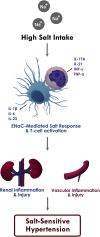Inflammation and oxidative stress in salt sensitive hypertension; The role of the NLRP3 inflammasome
- PMID: 36620210
- PMCID: PMC9814168
- DOI: 10.3389/fphys.2022.1096296
Inflammation and oxidative stress in salt sensitive hypertension; The role of the NLRP3 inflammasome
Abstract
Salt-sensitivity of blood pressure is an independent risk factor for cardiovascular disease and affects approximately half of the hypertensive population. While the precise mechanisms of salt-sensitivity remain unclear, recent findings on body sodium homeostasis and salt-induced immune cell activation provide new insights into the relationship between high salt intake, inflammation, and hypertension. The immune system, specifically antigen-presenting cells (APCs) and T cells, are directly implicated in salt-induced renal and vascular injury and hypertension. Emerging evidence suggests that oxidative stress and activation of the NLRP3 inflammasome drive high sodium-mediated activation of APCs and T cells and contribute to the development of renal and vascular inflammation and hypertension. In this review, we summarize the recent insights into our understanding of the mechanisms of salt-sensitive hypertension and discuss the role of inflammasome activation as a potential therapeutic target.
Keywords: hypertension; immunity; inflammasome; inflammation; salt sensitivity.
Copyright © 2022 Ertuglu, Mutchler, Yu and Kirabo.
Conflict of interest statement
The authors declare that the research was conducted in the absence of any commercial or financial relationships that could be construed as a potential conflict of interest.
Figures
Similar articles
-
Dendritic cell epithelial sodium channel induced inflammation and salt-sensitive hypertension.Curr Opin Nephrol Hypertens. 2024 Mar 1;33(2):145-153. doi: 10.1097/MNH.0000000000000963. Epub 2024 Jan 5. Curr Opin Nephrol Hypertens. 2024. PMID: 38180118 Free PMC article. Review.
-
Platelet Indices and RDW to Assess Inflammatory Milieu in Subclinical Hashimoto's Thyroiditis.Clin Med Insights Endocrinol Diabetes. 2025 Jun 13;18:11795514251349337. doi: 10.1177/11795514251349337. eCollection 2025. Clin Med Insights Endocrinol Diabetes. 2025. PMID: 40528863 Free PMC article.
-
Flavonoids regulating NLRP3 inflammasome: a promising approach in alleviating diabetic peripheral neuropathy.Inflammopharmacology. 2025 May;33(5):2231-2262. doi: 10.1007/s10787-025-01729-7. Epub 2025 Apr 9. Inflammopharmacology. 2025. PMID: 40205269 Free PMC article. Review.
-
The Interaction of Kidneys and Gut in Development of Salt-Sensitive Hypertension.Cardiol Rev. 2024 Jul-Aug 01;32(4):356-361. doi: 10.1097/CRD.0000000000000518. Epub 2023 Jun 5. Cardiol Rev. 2024. PMID: 37273192 Review.
-
Targeting Inflammation in Type 2 Diabetes: The Role of Colchicine.Curr Diabetes Rev. 2025 Jun 16. doi: 10.2174/0115733998298686250526041742. Online ahead of print. Curr Diabetes Rev. 2025. PMID: 40530726
Cited by
-
Differential changes in end organ immune cells and inflammation in salt-sensitive hypertension: effects of increasing M2 macrophages.Clin Sci (Lond). 2024 Jul 17;138(14):921-940. doi: 10.1042/CS20240699. Clin Sci (Lond). 2024. PMID: 38949840 Free PMC article.
-
Recent updates on the influence of iron and magnesium on vascular, renal, and adipose inflammation and possible consequences for hypertension.J Hypertens. 2024 Nov 1;42(11):1848-1861. doi: 10.1097/HJH.0000000000003829. Epub 2024 Sep 11. J Hypertens. 2024. PMID: 39258532 Free PMC article. Review.
-
Glycocalyx-Sodium Interaction in Vascular Endothelium.Nutrients. 2023 Jun 25;15(13):2873. doi: 10.3390/nu15132873. Nutrients. 2023. PMID: 37447199 Free PMC article. Review.
-
Dendritic cell epithelial sodium channel induced inflammation and salt-sensitive hypertension.Curr Opin Nephrol Hypertens. 2024 Mar 1;33(2):145-153. doi: 10.1097/MNH.0000000000000963. Epub 2024 Jan 5. Curr Opin Nephrol Hypertens. 2024. PMID: 38180118 Free PMC article. Review.
-
Salt sensitivity of blood pressure: mechanisms and sex-specific differences.Nat Rev Cardiol. 2025 Sep;22(9):611-628. doi: 10.1038/s41569-025-01135-0. Epub 2025 Feb 21. Nat Rev Cardiol. 2025. PMID: 39984695 Review.
References
-
- Babcock M. C., Robinson A. T., Migdal K. U., Watso J. C., Wenner M. M., Stocker S. D., et al. (2019). Reducing dietary sodium to 1000 mg per day reduces neurovascular transduction without stimulating sympathetic outflow. Hypertension 73, 587–593. (Dallas, Tex: 1979). 10.1161/HYPERTENSIONAHA.118.12074 - DOI - PMC - PubMed
Publication types
Grants and funding
LinkOut - more resources
Full Text Sources
Miscellaneous



